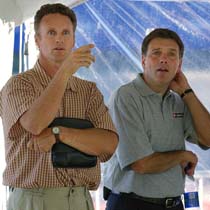Waterfront soccer venue just part of a shrewd development proposal
Miro Cernetig
Sun

General manager Bob Lenarduzzi of Vancouver Whitecaps (left) chats with owner Greg Kerfoot, who wants to put up $90 million of his own money to build a new soccer stadium on the Vancouver waterfront. Mark Van Manen/Vancouver Sun Files
It’s supposed to be the field of Vancouver‘s soccer dreams. But what will also be coming to the proposed new waterfront stadium isn’t just fans: it’s condos, condos, condos.
As the goal-challenged David Beckham has proven, yet again, professional soccer is a dubious bet on this side of the Atlantic, even with talent and celebrity jetted in to goose up the game’s image.
Soccer, on this continent, ranks somewhere between hockey and roller derby. It may take off some day I suppose, though we’ve been waiting a while. Just ask Pele.
So, it’s always intrigued me that one of our local business titans wants to dole out $90 million of his personal wealth to build a waterfront stadium for our local professional soccer team, the Vancouver Whitecaps. This is either a soccer nut, a sports visionary or a guy who is a very big risk taker.
Well, it turns out there’s another tag you might want to attach to Kerfoot: Shrewd real estate developer. While we’ve been concentrating on the soccer stadium, often dubbed as a selfless example of “sports philanthropism“, there’s been more at play than just generosity and love of sport.
The Vancouver billionaire has his eye on developing a large chunk of the land around the proposed stadium and, more specifically, using the air space above it. Kerfoot, I’m told, hopes to build a phalanx of towers around the new stadium, a major increase in density in the downtown and a skyline-changing development.
That’s maybe not such a bad idea, if done right. We’re a growing city and some more commercial and residential space is the future.
But there’s a serious complication here: that land Kerfoot wants to use is now occupied by railyards — a key part of Metro Vancouver’s port operations and its future as a Asia-Pacific trading centre.
In order to build his soccer palace and towers, Kerfoot needs to build it over a wide swathe of the old railyards, those familiar old tracks you see snaking along the waterfront of Gastown. Now, given that he owns the entire 18 acres those rails are on, that wouldn’t seem so difficult.
Yet it is.
The snag is the billionaire also needs to cut a deal with Port of Vancouver. That’s because half of his proposed soccer stadium needs to be sited on the port’s waterfront. But the Vancouver Port Authority is driving a hard deal. In exchange for that crucial piece of waterfront, they are asking Kerfoot for ownership to all of the railyard lands.
The federal agency’s thinking is that they need to guarantee the long-term existence of all the railway yards to ensure Vancouver retains a working port linked to the Pacific. It should be made clear that the Port Authority isn’t against him building atop the tracks; they just want the trains to keep rolling underneath, even out of sight.
So far, Kerfoot isn’t biting.
He’s offering up ownership to about only half of the railway lands. He wants to hang onto the real estate west of his stadium, where all the towers would go up.
Partly the reason is future profits. The half of the railyards closer to Vancouver‘s city centre will likely be worth more once they are developed than the eastern half.
But there’s another good reason to hold onto those railyards.
Once the stadium and towers start going up, engineers will need to drive massive pilings down into the railyards to support the structures. If you want to get an idea of how many pillars, walk under the road in front of the Pan Pacific Hotel one day. It’s a forest of concrete pilings.
To carry out that sort of buttressing, engineers would likely want to re-route some of the existing rail tracks or even get rid of some altogether. It would be a complex task.
As the current landlord, Kerfoot would only have to deal with Canadian Pacific, the railway that has the right of way on his land, to get that tricky job done. It would likely be a tough negotiation. But CP might have its price for the land, as it’s shown in the past with other railyards. But if Kerfoot needs to make such a deal with a new public agency, that is the Vancouver Port Authority, it’s probably going to be even tougher going. Port officials view the railyards as sacrosanct and want to retain their full capacity.
When you boil down this standoff, it’s the classic Vancouver dilemma: we’ve got the greasy traditional economy running into the glitzy new one of glass towers and entertainment complexes.
In Vancouver we’ve tended to go for the new over the old, often with terrific results. A case in point is the transformation of the False Creek industrial lands into new neighourhoods.
But in this case, the old economy may not be so easy to pave over. A soccer stadium would be nice. But not at the expense of our port. There’s a public interest in retaining the railyards, a strategic part of our Asia-Pacific trade, which, with apologies to David Beckham and Mr. Kerfoot, I bet has a much brighter future than soccer.
© The Vancouver Sun 2008



